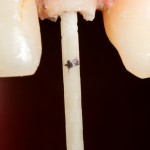
Restoring teeth following root canal therapy can present challenges particularly when significant amounts of tooth structure have been lost. The use of metal or non-metal posts and cores has been used to support restoration. The aim of this review was to analyze the outcome of clinical trials and cohort studies evaluating the post-retained restorations regarding the incidence rate of root fractures.
Methods
Medline and the OpenThesis databases were searched for randomised controlled trials (RCTs) and cohort studies reporting the incidence of root fractures of restorations retained with fibre-reinforced composite posts or metal posts of endodontically treated teeth. There were no language restrictions. Study selection and quality assessment was carried out independently by two reviewers. The Cochrane Risk of Bias Tool was used to assess RCTs and the Newcastle-Ottawa Scale for cohort studies. The primary outcome was root fracture leading to tooth extraction. Endodontic failures crown dislodgement, post debonding, and post/core fractures were secondary outcomes. The incidence rate of root fractures and non-catastrophic failures was calculated by dividing the number of events by the period of risk for all included posts during the study period per 1000 post years of follow- up.
Results
- 14 studies were included (7 RCTs, 7 Cohorts)
- incidence rate of root fractures (pooled event rate per 1000 post years ) for
- metal posts (4 RCTs,4 cohorts) = 5.13 (95% CI, 4.05–6.21)
- fibre-reinforced posts(5 RCTs, 3 cohorts) = 4.78 (95% CI, 4.28–5.27)
- heterogeneity across studies was high for both metal and fibre-reinforced posts
- The pooled survival rate for
- metal posts = 90% (95% CI 85.5– 93.3)
- fibre-reinforced posts = 83.9% (95% 67.6–92.8)
- Heterogeneity across studies was again high.
Conclusions
The authors concluded
The results of this study did not show significant differences for root fracture incidence between metal-and fibre posts. However, the studies included in this review presented a high risk of bias, and further well-designed clinical studies are required to confirm these findings.
Commentary
We have previous looked a trials and review on this topic (Dental Elf-28th Feb-2014) and a 2007 Cochrane review (Bolla et al) only included 2 RCTs. Only 3 of the 7 RCTs included in this review have been published since the Cochrane review. Only two databases were searched so it is possible that other relevant studies may be available. None of the included RCTs were at low risk of bias. The authors have chosen to include cohort studies and they note that the majority are retrospective so have greater risk of bias. They also highlight that although they did not identify any differences between the two types of post all the included studies were at high risk of bias so the findings need to be interpreted with caution.
Links
Original review protocol (PROSPERO-42014007423)
Dental Elf – 28th Feb 2014 -Trail suggests similar outcomes with cast and glass fibre posts
Bolla M, Muller-Bolla M, Borg C, Lupi-Pegurier L, Laplanche O, Leforestier E. Root canal posts for the restoration of root filled teeth. Cochrane Database of Systematic Reviews 2007, Issue 1. Art. No.: CD004623. DOI: 10.1002/14651858.CD004623.pub2.

Don’t miss – Root canal posts: no difference in root fracture incidence between metal-and fibre posts http://t.co/QHy39dTduA
@TheDentalElf what’s the difference in post fracture?
[…] Root canal posts: review suggests no difference in root fracture incidence between metal-and fibre p… […]